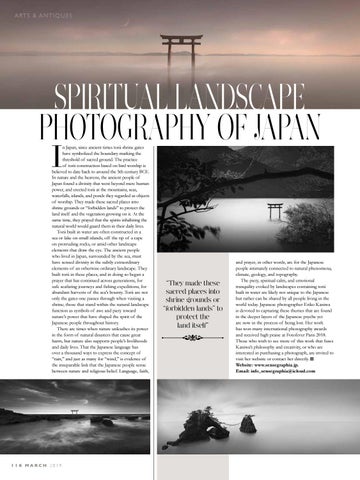ARTS & ANTIQUES
Spiritual Landscape Photography of Japan I
n Japan, since ancient times torii shrine gates have symbolized the boundary marking the threshold of sacred ground. The practice of torii construction based on bird worship is believed to date back to around the 5th century BCE. In nature and the heavens, the ancient people of Japan found a divinity that went beyond mere human power, and erected torii at the mountains, seas, waterfalls, islands, and ponds they regarded as objects of worship. They made these sacred places into shrine grounds or “forbidden lands” to protect the land itself and the vegetation growing on it. At the same time, they prayed that the spirits inhabiting the natural world would guard them in their daily lives. Torii built in water are often constructed in a sea or lake on small islands, off the tip of a cape on protruding rocks, or amid other landscape elements that draw the eye. The ancient people who lived in Japan, surrounded by the sea, must have sensed divinity in the subtly extraordinary elements of an otherwise ordinary landscape. They built torii in these places, and in doing so began a prayer that has continued across generations, for safe seafaring journeys and fishing expeditions, for abundant harvests of the sea’s bounty. Torii are not only the gates one passes through when visiting a shrine; those that stand within the natural landscape function as symbols of awe and piety toward nature’s power that have shaped the spirit of the Japanese people throughout history. There are times when nature unleashes its power in the form of natural disasters that cause great harm, but nature also supports people’s livelihoods and daily lives. That the Japanese language has over a thousand ways to express the concept of “rain,” and just as many for “wind,” is evidence of the inseparable link that the Japanese people sense between nature and religious belief. Language, faith,
116 MARCH 2019
“They made these sacred places into shrine grounds or “forbidden lands” to protect the land itself”
and prayer, in other words, are for the Japanese people intimately connected to natural phenomena, climate, geology, and topography. The piety, spiritual calm, and emotional tranquility evoked by landscapes containing torii built in water are likely not unique to the Japanese but rather can be shared by all people living in the world today. Japanese photographer Eriko Kaniwa is devoted to capturing these themes that are found in the deeper layers of the Japanese psyche yet are now in the process of being lost. Her work has won many international photography awards and received high praise at Fotofever Paris 2018. Those who wish to see more of this work that fuses Kaniwa’s philosophy and creativity, or who are interested in purchasing a photograph, are invited to visit her website or contact her directly. Website: www.sensegraphia.jp. Email: info_sensegraphia@icloud.com
